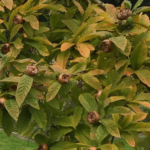The Medlar Tree
The Medlar
Mespilus Germanica

Medlars are excellent for the garden, ideal for an ornamental area of the garden and with a spreading form, giving interest in late Spring, early Summer blossom and good Autumn cololur. Related to the Quince but its fruit is only suitable for wine and preserves. The tree is slow growing and long lived eventually reaching about 5 metres in height
They fare well in our cold winters and will tolerate a long dry Summer. The yellow-centred single, white blossoms appears in May and are frequented by honey bees. Their fruits appear in the Autumn and can be used to make a delicous amber jelly to have with cheese and meat
I harvest my Medlar Tree in late October – early November, after night-time temperatures have dipped. The fruits are like large brown rose-hips and should be ‘bletted’ or ripened on trays in a cool environment, before eating or cooking. ‘Bletting’ liberates the fruits’ flavours and after about two weeks the Medlar becomes soft and juicy. Every year I make Medlar Jelly with the ‘bletted’ fruit
Dating back to the Greek civilisation, it is thought the Romans brought Medlars to Britain. First recorded in the UK in Saxon times, Medlars appear in Chaucer, Shakespeare and King Henry VIII had them planted at Hampton Court. The zenith of this tree’s popularity was in 1600s when it was widely grown across England and was as common as apples and pears! Up until the 1950s the fruit was still a Winter staple. Perhaps its demise is due to exotic fruit imports in the Winter months and the laborious task of ‘bletting’ the fruit prior to comsumption. Today it has vanished from UK supermarkets and greengrocers
Candida Hopkinson